Fluvisols
Table of contents
-
Introduction
-
Parent material and environment
-
Regional Distribution
-
Definition
-
Genesis
-
Characteristics of Fluvisols
a. Physical characteristics
b. Chemical characteristics
-
Management and Use of Fluvisols
1. Introduction
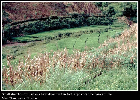 |
| Fig.1 Fluvisols, Thailand |
| (
Source: FAO, 2001.) |
-
The name Fluvisols refers to the Latin word fluvius =
river.
-
Fluvisols belong to the Reference Soil Groups set #4 of the
of the WRB reference system. This set includes mineral soils whose formation
was markedly influenced by their topographic/physiographic setting. Fluvisols
accommodate genetically young, azonal soils in alluvial deposits, which show
stratification or other evidence of recent sedimentation. Sediments can be
fluvial, lacustrine or marine (World Soil Resources Report 94, 2001). Worldwide
areas of sedimentation and sedimentation deposits are here:
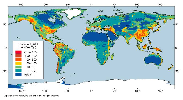 |
| Fig.2 Worldwide areas of
sedimentation |
|
-
The highest yields are from:
-
SE-Asia which receives high precipitation related to
the summer monsoon climate
-
and major high-relief mountain belts, including the
Himalaya, the Alp, the Andes
-
The coastal ranges of Alaska and British
Colombia
Further reading on the topographye/physiography of the
terrain, click
( here) here)
-
They are internationally known as:
-
Fluvents = Soil Taxonomy, USDA
-
Alluvial Soils = Russia, Australia
-
Auenböden = Germany
2. Parent material and environment
Parent material:
-
Recent (mainly Holocene sediments) fluvial, lacustrine or
marine alluvial deposits.
-
The texture of the parent material differs between terraces
and river banks or lagoons and basins.
Environment:
-
Periodically flooded areas of alluvial plains, river fans,
valleys and tidal marshes.
-
On all continents and in all climate zones.
3. Regional distribution
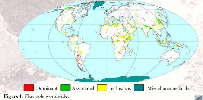 |
| Fig.3 Fluvisols worldwide |
| (
Source: FAO, 2001.) |
-
Worldwide about 350 Mio. ha (~ 3 %) consist of Fluvisols. The
areas represent important agricultural regions; ~ 50 % of the world population
lives along rivers and coasts.
-
Along rivers and lakes:
-
Amazonas, lowland of Lake Chad or marshland in Bolivia
and N-Argentina
-
Delta-areas:
-
Ganges/Brahmaputra, Indus, Mekong, Mississippi, Nile,
Niger, Orinoco, Rio de la Plata, Zambesi
-
Young marine deposits:
-
Sumatra, Kalimantan, Irian Jaya
4. Definition
-
Soils having a thickness of 25 cm or more.
-
Fluvic soil material starting within 50 cm from the soil
surface and continuing to a depth of at least 50 cm from the soil surface ->
see
 http://www.fao.org/DOCREP/003/Y1899E/Y1899E00.HTM http://www.fao.org/DOCREP/003/Y1899E/Y1899E00.HTM
a. Soil material which shows stratification in at least 25 %
of the soil volume.
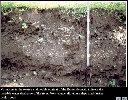 |
| Fig.4 Variation of texture and pebble content of
fluvial deposits |
| (
Source: FAO, 2001.) |
 |
| Fig.5 Aridic Fluvisol in Tunisia |
| (
Source: Zech und Hintermaier-Erhard, 2002.) |
b. Stratification is surmised if the organic carbon content
decreases irregularly with depth but remains greater than 0.2 % to a depth of
100 cm.
c. Fluvic soil material must be associated with structural
water bodies (seas, lakes and rivers).
5. Genesis
-
They are regularly flooded with depositions of fresh material
(unless the land was empoldered) and show stratification and/or an irregular
organic matter profile.
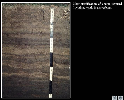 |
| Fig.6 Clear stratification of coarse textured
fluvial materials in a riverbank |
| (
Source: FAO, 2001.) |
-
They are young soils that developed a surface soil horizon
and have no further characteristics of soil formation.
-
Fluvisols in upstream parts of the river system are confined
to narrow strips of land (adjacent to the actual riverbed)
-
In the middle and lower stretches of the river,
a. coarsely textured Fluvisols are found on the
levees
b. and more finely textured Fluvisols in basins
-
In areas with marine sediments:
a. Coarse-textured Fluvisols occur on barrieres, cheniers,
sand flats and crevasse splays
b. Finely textured Fluvisols are found on clayey tidal flats
and in chenier plains
See further:
( Fluvisols
topography) Fluvisols
topography)
6. Characteristics of Fluvisols
6a. Physical
characteristics:
-
Wet in all or parts of the profile due to stagnating
groundwater and/or flood water from rivers or tides.
-
Terraces and river levees are much better drained than soils
in low landscape positions.
-
Texture can vary from coarse sand in levee soils to heavy
clays in basin areas.
-
Most Fluvisols show mottling indicative of alternating
reducing and oxidizing conditions.
b. Chemical
characteristics:
-
By and large, Fluvisols are fertile (depending on the
deposited material).
-
Neutral pH, good to high base saturation.
7. Management and use of Fluvisols
-
Good natural fertility (young soils), many civilizations
along river landscapes.
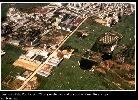 |
| Fig.7 Fluvisols, China |
| (
Source: FAO, 2001.) |
-
Paddy rice cultivation is widespread.
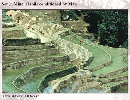 |
| Fig.8 Sawah landscape in Indonesia |
| (
Source: FAO, 2001.) |
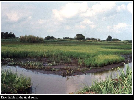 |
| Fig.9 Paddy rice field should be dry for a few
weeks to prevent drop of redox potential (H2S problem) but also to stimulate
microbial activity and promote mineralization of SOM |
| (
Source: FAO, 2001.) |
-
Tidal lands are often used for shrimp farming.
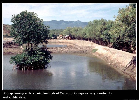 |
| Fig.10 Shrimp farming in the coastal lowlands of
Vietnam |
| (
Source: FAO, 2001.) |
|

 previous | next
previous | next

 previous | next
previous | next